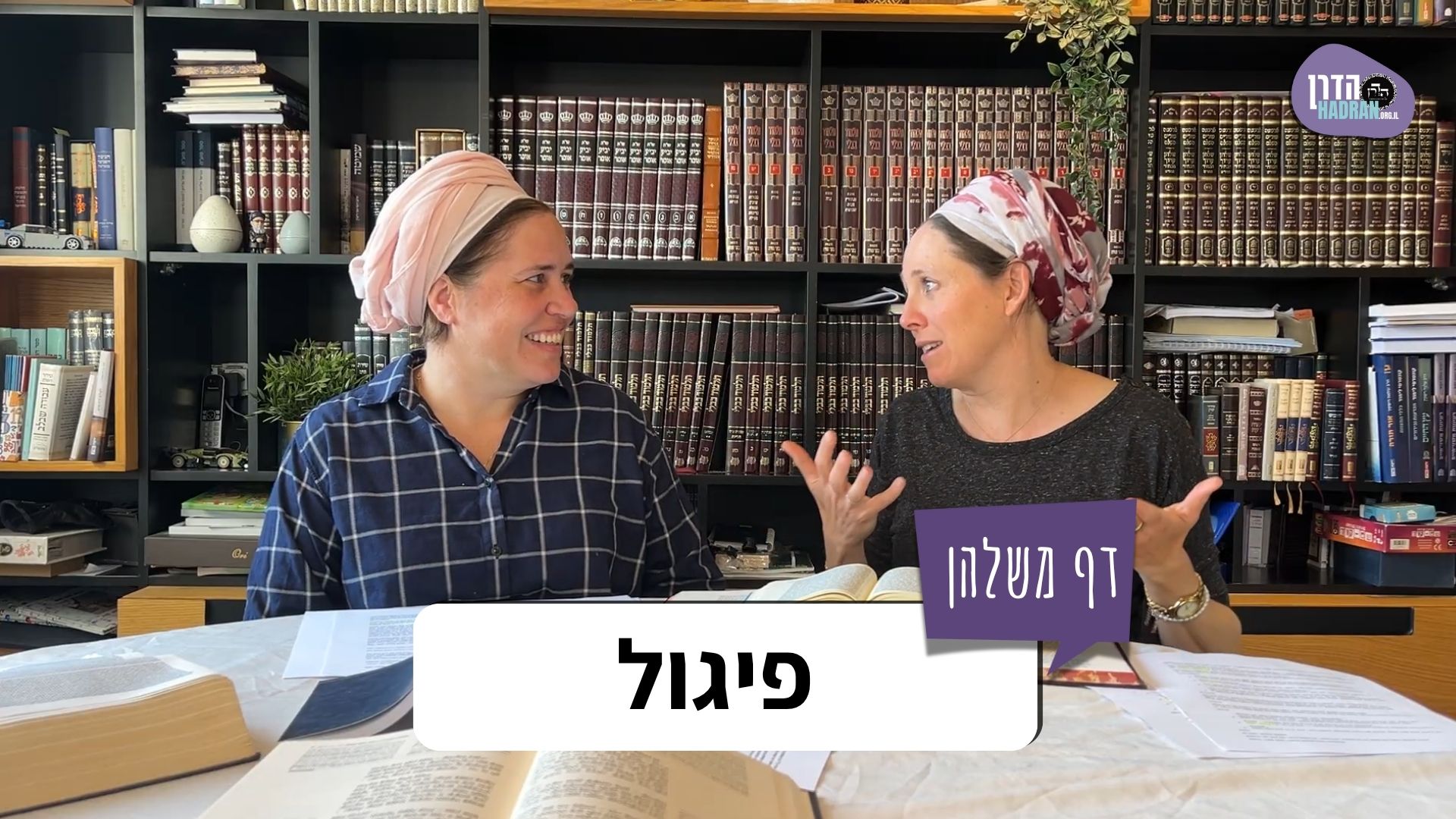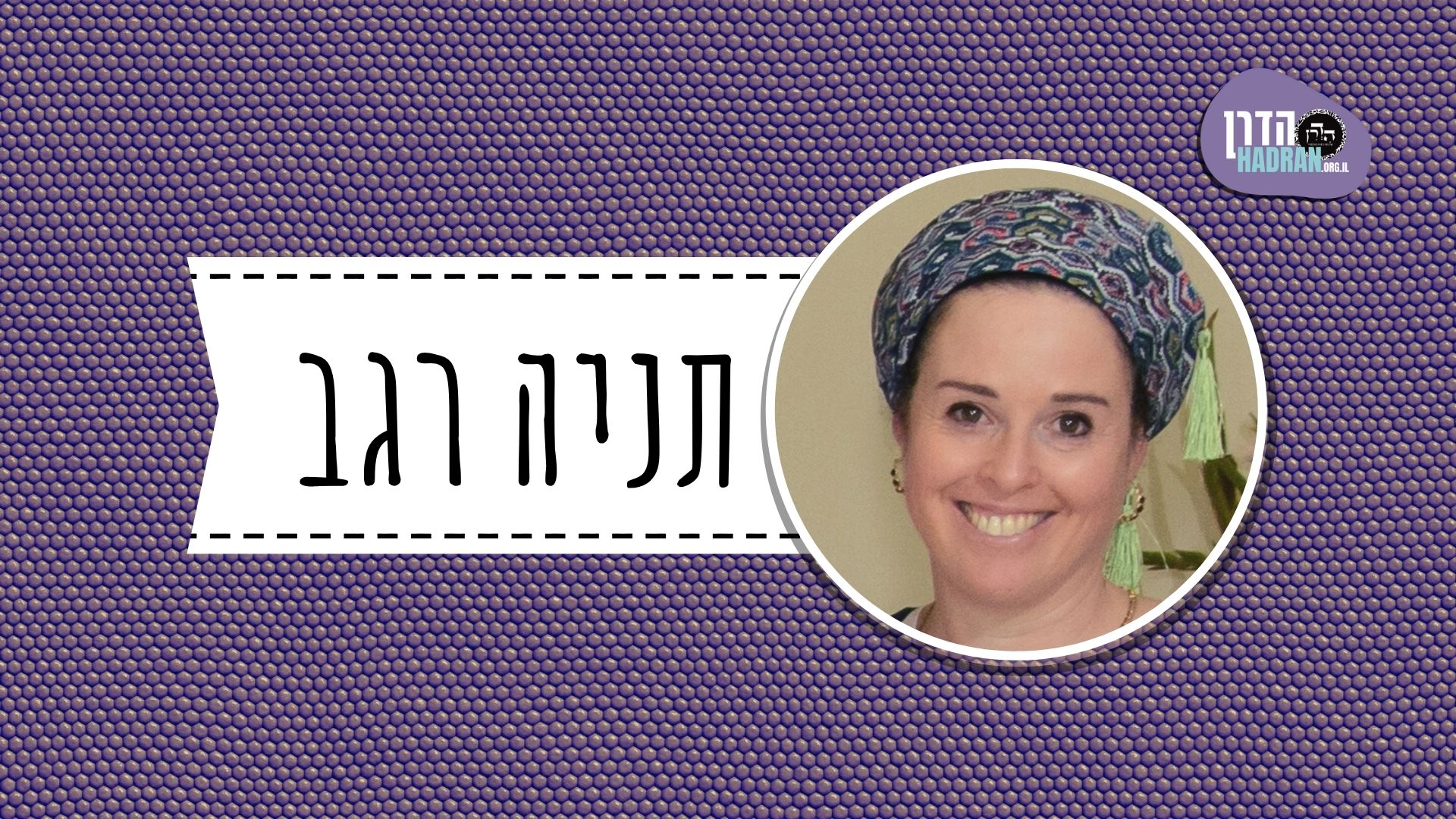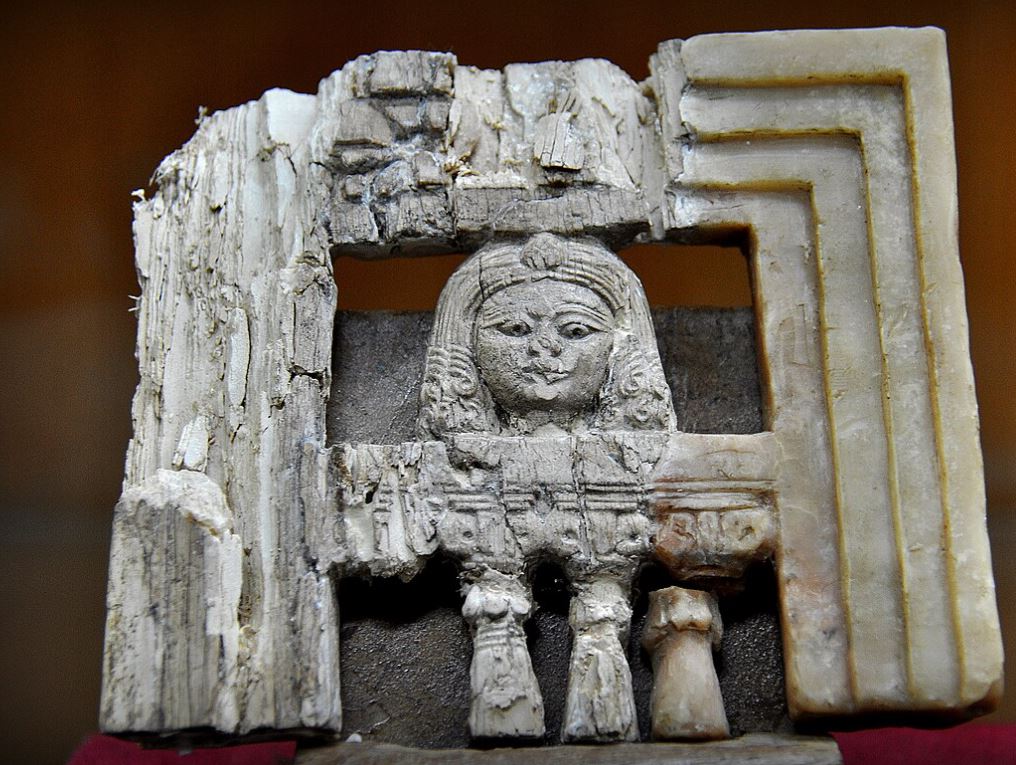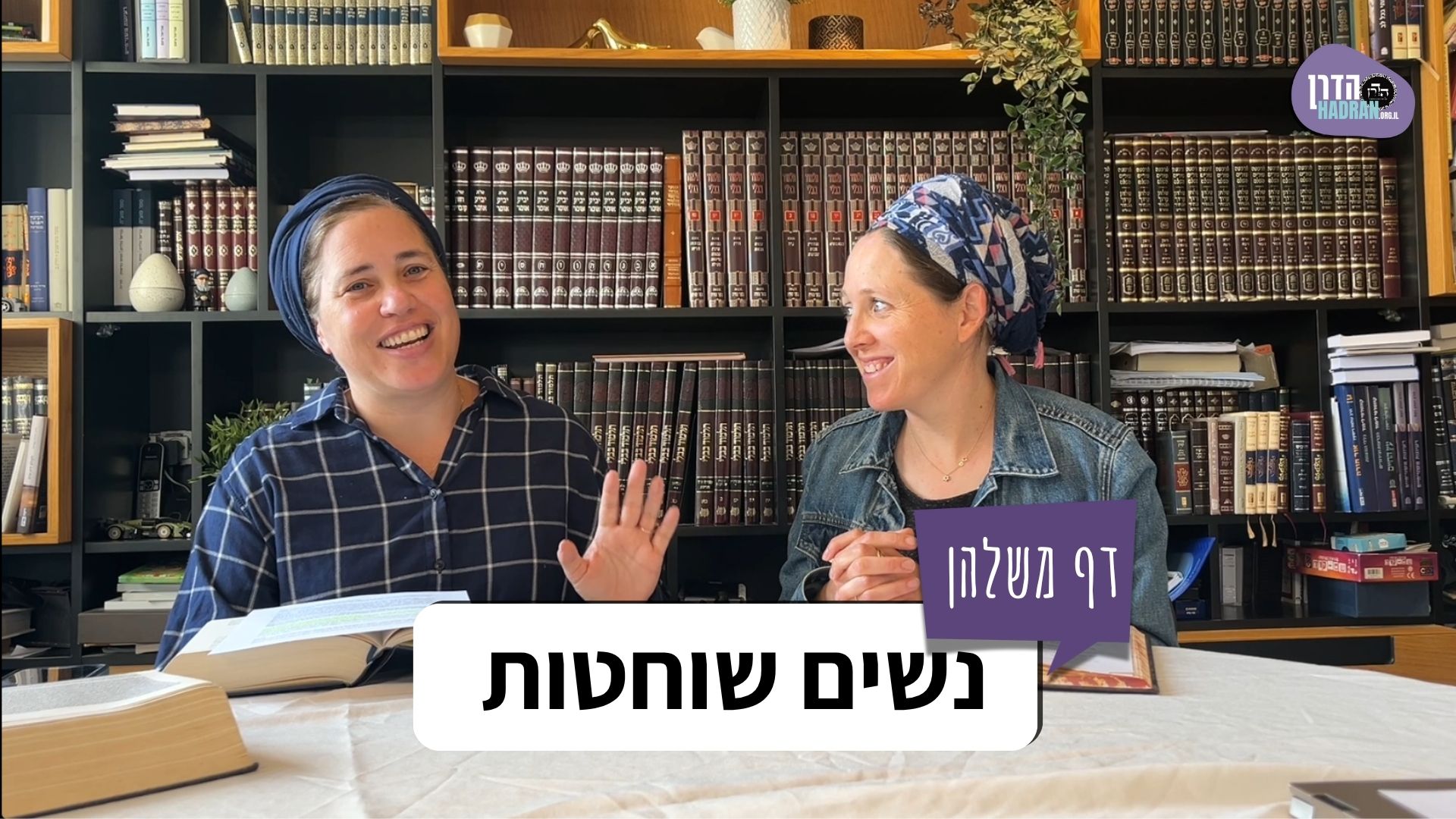עוד דיונים במומים בבהמות – מה נחשב מום ומה לא? איזה ויכוחים היו לחכמים לגבי מומים מסויימים? מהן טעמי המצווה של איסור הקרבת בעל מום?
לימוד החודש מוקדש ע”י בט בלקני לכבוד נכדתה, דבורה חנה סרח אייכל.
רוצים להקדיש למידה? התחל כאן:

לימוד החודש מוקדש ע”י בט בלקני לכבוד נכדתה, דבורה חנה סרח אייכל.
העמקה
רוצה להבין מה באמת קורה מתחת לפני השטח של הסוגיה?
שיעורים, פודקאסטים והרחבות של מיטב המורות שלנו יפתחו לך עוד זוויות וכיווני חשיבה.
חדשה בלימוד הגמרא?
זה הדף הראשון שלך? איזו התרגשות עצומה! יש לנו בדיוק את התכנים והכלים שיעזרו לך לעשות את הצעדים הראשונים ללמידה בקצב וברמה שלך, כך תוכלי להרגיש בנוח גם בתוך הסוגיות המורכבות ומאתגרות.
פסיפס הלומדות שלנו
גלי את קהילת הלומדות שלנו, מגוון נשים, רקעים וסיפורים. כולן חלק מתנועה ומסע מרגש ועוצמתי.
בכורות מ
בְּשׁוּשַׁן הַבִּירָה, אַחַת עַל קֶרֶן מִזְרָחִית צְפוֹנִית וְאַחַת עַל קֶרֶן מִזְרָחִית דְּרוֹמִית, שֶׁעַל קֶרֶן מִזְרָחִית צְפוֹנִית הָיְתָה יְתֵירָה עַל שֶׁל מֹשֶׁה חֲצִי אֶצְבַּע, וְשֶׁעַל קֶרֶן מִזְרָחִית דְּרוֹמִית הָיְתָה יְתֵירָה עָלֶיהָ חֲצִי אֶצְבַּע, נִמְצֵאת יְתֵירָה עַל שֶׁל מֹשֶׁה אֶצְבַּע.
in the chamber of Shushan the capital, which was located above the eastern gate of the Temple Mount, one in the northeast corner and one in the southeast corner. The one that was in the northeast corner was longer than the cubit used by Moses in the building of the Tabernacle, which was six handbreadths, by half a fingerbreadth, and the one that was in the southeast corner was longer than the other one by another half a fingerbreadth. One therefore finds it longer than Moses’ cubit by a full fingerbreadth.
וְלָמָה הָיוּ אַחַת גְּדוֹלָה וְאַחַת קְטַנָּה? (כשהיו) [שֶׁהָיוּ] אוּמָּנִין נוֹטְלִין בַּקְּטַנָּה, וּמַחְזִירִין בַּגְּדוֹלָה, שֶׁלֹּא יָבוֹאוּ לִידֵי מְעִילָה.
The mishna continues: And why did the Sages say that there should be two measures of a cubit, one large and one small? It was so that the artisans who were working in the Temple would take payment according the amount of work they did, as measured by the small cubit, and return it to the Temple through their work, as measured by the large cubit, so they would not come to misuse consecrated property. If they would accept any payment that they did not deserve, they would be misusing consecrated property. It was with regard to the fingerbreadth mentioned in this mishna that the baraita cited above teaches that it is one-fourth of a handbreadth of any average person.
תַּרְתֵּי לְמָה לִי? חֲדָא — דְּכַסְפָּא וְזַהֲבָא, וַחֲדָא — דְּבִנְיָינָא.
The Gemara asks: Why do I need two large cubits? The Gemara answers: One, the shorter of the two, was used to measure silver and gold. Since silver and gold were valuable, the difference between the two measurements was set at only half a fingerbreadth, so that the artisans would not suffer too great a loss. And the other one, which was longer than Moses’ cubit by a full fingerbreadth, was used in the construction of wood and stone structures.
רַב נַחְמָן בַּר יִצְחָק, וְאִי תֵּימָא רַב הוּנָא בַּר נָתָן, לְאוֹתָהּ שֶׁשָּׁנִינוּ: שֶׁיֵּשׁ בָּשָׂר בֵּין חוּלְיָא לְחוּלְיָא מְלֹא אֶצְבַּע.
Rav Naḥman bar Yitzḥak, and some say Rav Huna bar Natan, said: This baraita, which states that a fingerbreadth is one-fourth of a handbreadth of any average person, is referring to that which we learned in the mishna here with regard to the blemishes of a firstborn animal: In a case where there is a full fingerbreadth of flesh between one joint and another joint. That measure of a full fingerbreadth is one-fourth of a handbreadth.
מַתְנִי׳ אֵין לוֹ בֵּיצִים, אוֹ אֵין לוֹ אֶלָּא בֵּיצָה אַחַת. רַבִּי יִשְׁמָעֵאל אוֹמֵר: אִם יֵשׁ לוֹ שְׁנֵי כִּיסִין — יֵשׁ לוֹ שְׁתֵּי בֵּיצִים, אֵין לוֹ שְׁנֵי כִּיסִין — אֵין לוֹ אֶלָּא בֵּיצָה אַחַת. רַבִּי עֲקִיבָא אוֹמֵר: מוֹשִׁיבוֹ עַל עַכּוּזוֹ וּמְמַעֵךְ, אִם יֵשׁ בֵּיצָה — סוֹפָהּ לָצֵאת. מַעֲשֶׂה שֶׁמִּיעֵךְ וְלֹא יָצָא, נִשְׁחֲטָה וְנִמְצֵאת דְּבוּקָה בַּכְּסָלִים, וְהִתִּיר רַבִּי עֲקִיבָא וְאָסַר רַבִּי יוֹחָנָן בֶּן נוּרִי.
MISHNA: The firstborn animal may be slaughtered if it has no testicles or if it has only one testicle. Rabbi Yishmael says: If the animal has two scrotal sacs, it can be assumed that it has two testicles; if the animal does not have two scrotal sacs, it can be assumed that it has only one testicle. Rabbi Akiva says: The matter can be ascertained: One seats the animal on its rump and mashes the sac; if there is a testicle, ultimately it is going to emerge. There was an incident where one mashed the sac and the testicle did not emerge. Then, the animal was slaughtered and the testicle was discovered attached to the loins. And Rabbi Akiva permitted the consumption of its flesh, as the testicle had not previously emerged, and Rabbi Yoḥanan ben Nuri prohibited its consumption.
גְּמָ׳ הַשְׁתָּא אֵין לוֹ אֶלָּא בֵּיצָה אַחַת אָמְרַתְּ הָוֵי מוּמָא, אֵין לוֹ כְּלָל מִיבַּעְיָא? חַסּוֹרֵי מִיחַסְּרָא וְהָכִי קָתָנֵי: אֵין לוֹ שְׁתֵּי בֵּיצִים בִּשְׁתֵּי כִּיסִין אֶלָּא בְּכִיס אֶחָד, אִי נָמֵי שְׁתֵּי כִּיסִין וּבֵיצָה אַחַת — הֲרֵי זֶה מוּם.
GEMARA: The mishna teaches that a firstborn may be slaughtered if it has no testicles or if it has only one testicle. The Gemara asks: Now that with regard to a case where it has only one testicle you said that it is a blemish, is it necessary to state the same in a case where it has no testicles at all? The Gemara answers that the mishna is incomplete and this is what it is teaching: If it does not have two testicles in two scrotal sacs, but in one sac, or alternatively, if it has two sacs and one testicle, it is a blemish.
רַבִּי יִשְׁמָעֵאל אוֹמֵר: יֵשׁ לוֹ שְׁתֵּי כִּיסִים — בְּיָדוּעַ שֶׁיֵּשׁ לוֹ שְׁתֵּי בֵּיצִים, אֵין לוֹ אֶלָּא כִּיס אֶחָד — כְּמִי שֶׁאֵין לוֹ אֶלָּא בֵּיצָה אַחַת דָּמֵי, וַאֲתָא רַבִּי עֲקִיבָא לְמֵימַר: בְּיָדוּעַ לָא אָמְרִינַן, אֶלָּא מוֹשִׁיבוֹ עַל עַכּוּזוֹ וּמְמַעֵךְ, אִם יֵשׁ בֵּיצָה סוֹפוֹ לָצֵאת.
The Gemara continues this version of the mishna. Rabbi Yishmael says: If the animal has two scrotal sacs, it is known that it has two testicles, and therefore it is not blemished and may not be slaughtered; if the animal has only one scrotal sac it is considered like one that has only one testicle, even if it actually has two testicles. And Rabbi Akiva comes to say: If it has two sacs, we do not say the claim of: It is known. Rather, one seats the animal on its rump and mashes the sac; if there is a testicle, ultimately it is going to emerge. If the testicle does not emerge, clearly it has only one testicle and is blemished.
וּמַעֲשֶׂה שֶׁמִּיעֵךְ וְלֹא יָצָא וְכוּ׳. תַּנְיָא, אָמַר רַבִּי יוֹסֵי: מַעֲשֶׂה בְּפָירָן שֶׁל בֵּית מְנַחֵם, שֶׁמִּיעֵךְ וְלֹא יָצָאת, וְנִשְׁחֲטָה וְנִמְצֵאת דְּבוּקָה בַּכְּסָלִים, וְהִתִּיר רַבִּי עֲקִיבָא, וְאָסַר רַבִּי יוֹחָנָן בֶּן נוּרִי.
§ The mishna teaches: And there was an incident where one mashed the sac and the testicle did not emerge. Then the animal was slaughtered and the testicle was discovered attached to the loins. And Rabbi Akiva permitted the consumption of its flesh, and Rabbi Yoḥanan ben Nuri prohibited its consumption. The Gemara elaborates on this incident: It is taught in a baraita that Rabbi Yosei said: There was an incident in Piran of Beit Menaḥem where a firstborn animal apparently had only one testicle, and someone mashed its sac and the other testicle did not emerge. And the animal was slaughtered and the testicle was discovered attached to the loins. And Rabbi Akiva permitted its consumption, and Rabbi Yoḥanan ben Nuri prohibited its consumption.
אָמַר לוֹ רַבִּי עֲקִיבָא לְרַבִּי יוֹחָנָן בֶּן נוּרִי: עַד מָתַי אַתָּה מְכַלֶּה מָמוֹנָן שֶׁל יִשְׂרָאֵל! אָמַר לוֹ רַבִּי יוֹחָנָן בֶּן נוּרִי לְרַבִּי עֲקִיבָא: עַד מָתַי אַתָּה מַאֲכִיל יִשְׂרָאֵל נְבֵילוֹת! לָאו מִישְׁחָט שַׁחְטֵיהּ?
The baraita continues: Rabbi Akiva said to Rabbi Yoḥanan ben Nuri: Until when will you consume the property of the Jewish people by prohibiting animals in such cases? Rabbi Yoḥanan ben Nuri said to Rabbi Akiva: Until when will you feed the Jewish people unslaughtered animal carcasses? The Gemara asks: How could Rabbi Yoḥanan ben Nuri use the term animal carcasses here? After all, aren’t they properly slaughtered?
אֶלָּא: טְרֵיפוֹת. לָא אִיסּוּר טְרֵיפוֹת הוּא?! אֶלָּא: עַד מָתַי אַתָּה מַאֲכִיל יִשְׂרָאֵל קָדָשִׁים בַּחוּץ!
The Gemara responds: Rather, Yoḥanan ben Nuri actually referred to animals with a wound that will cause them to die within twelve months [tereifot]. The Gemara challenges: But it is not a prohibition of tereifot. Rather, he said: Until when will you feed the Jewish people sacrificial animals outside the Temple courtyard? According to Rabbi Yoḥanan ben Nuri this is not a blemish, and therefore the animal is an unblemished offering, which may not be eaten outside the Temple.
מַתְנִי׳ בַּעַל חָמֵשׁ רַגְלַיִם, אוֹ שֶׁאֵין לוֹ אֶלָּא שָׁלֹשׁ, וְשֶׁרַגְלָיו קְלוּטוֹת כְּשֶׁל חֲמוֹר, וְהַשָּׁחוּל וְהַכָּסוּל. אֵיזֶהוּ שָׁחוּל? שֶׁנִּשְׁמְטָה יְרֵיכוֹ. וְכָסוּל? שֶׁאַחַת מִירֵיכוֹתָיו גְּבוֹהוֹת.
MISHNA: An animal with five legs, or one that has only three, or one whose hooves on its legs were closed like those of a donkey and not split, or the shaḥul, or the kasul may be slaughtered. What is a shaḥul? It is an animal with a thighbone that was dislocated. And what is a kasul? It is an animal whose build is asymmetrical in that one of its thighs is higher than the other.
גְּמָ׳ אָמַר רַב הוּנָא: לֹא שָׁנוּ אֶלָּא שֶׁחָסֵר וְיָתֵר בַּיָּד, אֲבָל בָּרֶגֶל — טְרֵפָה נָמֵי הָוֵי, דְּכֹל יָתֵיר כְּנָטוּל דָּמֵי.
GEMARA: The mishna teaches that an animal with five legs or three legs is blemished. Rav Huna says: The Sages taught this only in a case where the animal was missing or had an additional foreleg. But if it was missing or had an additional hind leg, not only is it blemished, but it is also a tereifa. The reason is that any extra limb is like a removed limb, and an animal whose hind leg was removed is a tereifa.
אָמַר רַב פָּפָּא: לָא תֵּימָא דַּעֲגִילָן וְלָא סְדִיקָן, אֶלָּא כֵּיוָן דַּעֲגִילָן, אַף עַל גַּב דִּסְדִיקָן.
With regard to the ruling of the mishna that an animal whose hooves were closed like those of a donkey is blemished, Rav Pappa says: Do not say that it is a blemish only in a case where its hooves are entirely like those of a donkey, i.e., round and not split at all. Rather, when they are round, even though they are also split, it is still considered a blemish.
וְהַשָּׁחוּל וְהַכָּסוּל וְכוּ׳. תָּנוּ רַבָּנַן: אֵיזֶהוּ כָּסוּל וְאֵיזֶהוּ שָׁחוּל? שָׁחוּל — שֶׁנִּשְׁמְטָה יְרֵיכוֹ, כָּסוּל — שֶׁרַגְלוֹ אֶחָד בְּתוֹךְ הַכֶּסֶל, וְרַגְלוֹ אֶחָד עַל גַּבֵּי הַכֶּסֶל. תָּנָא: הַשָּׂרוּעַ וְהַקָּלוּט — שָׂרוּעַ שֶׁנִּשְׁתַּרְבֵּב לוֹ יְרֵיכוֹ, קָלוּט — שֶׁרַגְלָיו קְלוּטוֹת כְּשֶׁל חֲמוֹר וּכְשֶׁל סוּס.
The mishna teaches: Or the shaḥul, or the kasul may be slaughtered. In this regard, the Sages taught: What is the kasul and what is the shaḥul? The shaḥul is an animal with a thighbone that was dislocated. The kasul is an animal that is irregular in that one of its legs is inside the loin, i.e., in its proper place, and in one of its legs the bone is dislocated and is above the loin. It is taught in a baraita: What are the saru’a and kalut mentioned in the Torah (see Leviticus 22:23) among the animals disqualified from being sacrificed? The saru’a is one whose thigh is longer than the other; the kalut is one whose hooves on its legs are closed like those of a donkey and like those of a horse.
מַתְנִי׳ נִשְׁבַּר עֶצֶם יָדוֹ וְעֶצֶם רַגְלוֹ, אַף עַל פִּי שֶׁאֵינוֹ נִיכָּר. מוּמִין אֵלּוּ מָנָה אִילָא בְּיַבְנֶה, וְהוֹדוּ לוֹ חֲכָמִים.
MISHNA: Additional blemishes that permit the slaughter of the firstborn include those where the bone of its foreleg or the bone of its hind leg was broken, even though it is not conspicuous. With regard to these blemishes listed in this chapter, Ila, who was expert in blemishes of the firstborn, enumerated them in Yavne, and the Sages deferred to his expertise.
וְעוֹד שְׁלֹשָׁה הוֹסִיף, אָמְרוּ לוֹ: לֹא שָׁמַעְנוּ אֶת אֵלּוּ. שֶׁגַּלְגַּל עֵינוֹ עָגוֹל כְּשֶׁל אָדָם, וּפִיו דּוֹמֶה כְּשֶׁל חֲזִיר, וְשֶׁנִּיטַּל רוֹב הַמְדַבֵּר בִּלְשׁוֹנוֹ. בֵּית דִּין שֶׁל אַחֲרֵיהֶן אָמְרוּ: הֲרֵי זֶה מוּם.
And Ila added three additional blemishes, and the Sages said to him: We did not hear about those. Ila added: An animal whose eye is round like that of a person, or whose mouth is similar to that of a pig, or where most of the segment of its tongue corresponding to the segment that facilitates speech in the tongue of a person was removed. The court that followed them said with regard to each of those three blemishes: That is a blemish that enables the slaughter of the firstborn.
גְּמָ׳ אֵינוֹ נִיכָּר, מִי קָא הָוֵי מוּמָא? אָמַר רַב פָּפָּא: אֵינוֹ נִיכָּר מֵחֲמַת עַצְמוֹ, אֲבָל נִיכָּר מֵחֲמַת מְלָאכָה.
GEMARA: The mishna teaches that if the bone of its foreleg or the bone of its hind leg was broken it is considered a blemish, despite the fact that it is not conspicuous. The Gemara asks: If it is not conspicuous, is it a blemish? A blemish must be on an exposed part of the body (see 37b). Rav Pappa says: The mishna means that it is not conspicuous on its own account, i.e., the shape of the leg is no different from the usual. But it is conspicuous on account of its work, i.e., the manner in which the animal walks.
מוּמִין אֵלּוּ מָנָה וְכוּ׳. לְמֵימְרָא דְּלָאו הַיְינוּ אוֹרְחֵיהּ? וּרְמִינְהוּ: הַמַּפֶּלֶת מִין בְּהֵמָה וְחַיָּה וָעוֹף, בֵּין טְמֵאִין בֵּין טְהוֹרִין, אִם זָכָר תֵּשֵׁב לְזָכָר.
§ The mishna teaches that with regard to these blemishes listed in this chapter, Ila enumerated them in Yavne, and he added three more, including an animal whose eye is round like that of a person. The Gemara asks: Is this to say that it is not the manner of animals to have eyes of this kind? And one can raise a contradiction from a mishna (Nidda 21a): With regard to a woman who miscarries a fetus in the form of a type of domesticated animal, undomesticated animal, or bird, whether it is a non-kosher animal or whether it is a kosher animal, if it is male, the woman observes the periods of impurity, i.e., seven days, and purity, i.e., thirty-three days, established in the Torah for a woman who gives birth to a male.
אִם נְקֵבָה — תֵּשֵׁב לִנְקֵבָה, אֵינוֹ יָדוּעַ — תֵּשֵׁב לְזָכָר וְלִנְקֵבָה, דִּבְרֵי רַבִּי מֵאִיר.
If it is female, the woman observes the periods of impurity, i.e., fourteen days, and purity, i.e., sixty-six days, established in the Torah for a woman who gives birth to a female. If its sex is unknown, the woman observes the more severe restrictions from the case of the birth of a male and the more severe restrictions from the case of the birth of a female: She is impure for fourteen days like a woman who gave birth to a female, but blood that she sees thereafter is pure until only forty days after birth, like a woman who gave birth to a male. This is the statement of Rabbi Meir.
וְאָמַר רַבָּה בַּר בַּר חָנָה אָמַר רַבִּי יוֹחָנָן: מַאי טַעְמֵיהּ דְּרַבִּי מֵאִיר? הוֹאִיל וְגַלְגַּל עֵינוֹ עָגוֹל כְּשֶׁל אָדָם! אָמַר רַב יוֹסֵף: לָא קַשְׁיָא, הָא בְּאוּכָּמָא, הָא בְּחִיוָּורָא.
And Rabba bar bar Ḥana says that Rabbi Yoḥanan says: What is the reason of Rabbi Meir? Since the eye of these animals is round like that of a person, a woman who miscarries a fetus of this kind is impure. Rav Yosef said in resolution of this apparent contradiction: It is not difficult; this is referring to the black portion of the eye, whereas that is referring to the white portion of the eye.
וּפִיו דּוֹמֶה כְּשֶׁל חֲזִיר. אָמַר רַב פָּפָּא: לָא תֵּימָא דִּשְׁפִיד וּפְרִוס, אֶלָּא כֵּיוָן דִּפְרִוס אַף עַל גַּב דְּלָא שְׁפִיד.
The mishna teaches: Or its mouth is similar to that of a pig. Rav Pappa says: Do not say that this is referring only to a case where the mouth is pointed and the upper lip overlaps the bottom lip, exactly like that of a pig. Rather, when it overlaps, even though it is not pointed, this is a blemish.
וְשֶׁנִּיטַּל רוֹב הַמְדַבֵּר שֶׁבִּלְשׁוֹנוֹ. מַתְנִיתִין מַנִּי? רַבִּי יְהוּדָה הִיא, דְּתַנְיָא: וְאֶת שֶׁנִּיטַּל רוֹב הַלָּשׁוֹן, רַבִּי יְהוּדָה אוֹמֵר: רוֹב הַמְדַבֵּר שֶׁל לְשׁוֹנוֹ.
The mishna teaches: Or that most of the segment of its tongue corresponding to the segment that facilitates speech in the tongue of a person was removed. The Gemara asks: Whose opinion is expressed in the mishna? It is the opinion of Rabbi Yehuda, as it is taught in a baraita: Or that most of its tongue was removed; Rabbi Yehuda says: Most of the segment of its tongue corresponding to the segment that facilitates speech in the tongue of a person must be removed to be considered a blemish.
מַתְנִי׳ וּמַעֲשֶׂה שֶׁהַלְּחִי הַתַּחְתּוֹן עוֹדֵף עַל הָעֶלְיוֹן, וְשָׁאַל רַבָּן גַּמְלִיאֵל לַחֲכָמִים, וְאָמְרוּ: הֲרֵי זֶה מוּם.
MISHNA: And there was an incident where the lower jaw of the firstborn protruded beyond the upper jaw, and Rabban Gamliel asked the Sages for a ruling, and they said: That is a blemish that enables the slaughter of the firstborn.
גְּמָ׳ מַאי תַּנָּא דְּקָתָנֵי ״וּמַעֲשֶׂה״? מִשּׁוּם דִּתְנַן ״פִּיו דּוֹמֶה לַחֲזִיר״, וּפְלִיגִי רַבָּנַן עֲלֵיהּ דְּרַבִּי, וְקָאָמְרִינַן: כִּי פְּלִיגִי רַבָּנַן עֲלֵיהּ דְּרַבִּי בִּשְׂפָתוֹ עֶלְיוֹנָה עוֹדֶפֶת עַל הַתַּחְתּוֹנָה, אֲבָל שֶׁהַתַּחְתּוֹנָה עוֹדֶפֶת עַל הָעֶלְיוֹנָה — הֲרֵי זֶה מוּם.
GEMARA: The Gemara asks: What is the ruling taught in the previous mishna that the tanna is referring to when he teaches here: And there was an incident? The Gemara answers: Since we learned in the list of blemishes in the previous mishna the case where its mouth is similar to that of a pig, and the Rabbis disagree with Rabbi Ila in that case, we say here that when the Rabbis disagree with Rabbi Ila, it is only in a case where its upper lip overlaps the lower lip. But in a case where the lower jaw protrudes beyond the upper jaw, everyone agrees that this is a blemish.
וּמַעֲשֶׂה נָמֵי שֶׁלְּחִי הַתַּחְתּוֹן עוֹדֵף עַל הָעֶלְיוֹן, שָׁאַל רַבָּן שִׁמְעוֹן בֶּן גַּמְלִיאֵל לַחֲכָמִים וְאָמְרוּ: הֲרֵי זֶה מוּם.
The Gemara continues this version of the mishna: And there was also an incident where the lower jaw of the firstborn protruded beyond the upper jaw, and Rabban Shimon ben Gamliel asked the Sages for a ruling, and they said: That is a blemish that enables the slaughter of the firstborn.
וְהָא גַּבֵּי אָדָם הוּא דִּתְנַן: שְׂפָתוֹ הָעֶלְיוֹנָה עוֹדֶפֶת עַל הַתַּחְתּוֹנָה, אוֹ שֶׁתַּחְתּוֹנָה עוֹדֶפֶת עַל הָעֶלְיוֹנָה — הֲרֵי זֶה מוּם. גַּבֵּי אָדָם הוּא דִּכְתִיב: ״אִישׁ אִישׁ מִזֶּרַע אַהֲרֹן״, אִישׁ שֶׁשָּׁוֶה בְּזַרְעוֹ שֶׁל אַהֲרֹן, אֲבָל בִּבְהֵמָה לָא!
The Gemara challenges: But it is with regard to the blemishes of a person that we learned in a mishna (44a): If his upper lip protrudes beyond the lower lip or his lower lip protrudes beyond the upper lip, that is a blemish. And it is only with regard to a person that it is written: “Whatever man of the seed of Aaron” (Leviticus 22:4), which teaches that in order to be fit for the Temple service a priest must be a man who is equal to the seed of Aaron, i.e., he has an ordinary appearance like other priests. But this requirement is not stated with regard to an animal, and therefore an animal should not be considered blemished if its lower lip protrudes beyond the upper lip.
אָמַר רַב פָּפָּא: לָא קַשְׁיָא, הָא דְּאִית בַּהּ עֶצֶם, הָא דְּלֵית בַּהּ עֶצֶם.
Rav Pappa said in response: That is not difficult; this mishna is referring to a case where the lower jaw contains a bone that is longer than the upper jaw, in which case it is a blemish even for an animal, whereas that mishna is referring to a case where the lower jaw does not contain a bone, and therefore it is a blemish only in the case of a person.
מַתְנִי׳ אוֹזֶן הַגְּדִי הָיְתָה כְּפוּלָה, אָמְרוּ חֲכָמִים: בִּזְמַן שֶׁהוּא עֶצֶם אֶחָד — מוּם, בִּזְמַן שֶׁאֵין בּוֹ עֶצֶם — אֵינוֹ מוּם. רַבִּי חֲנַנְיָא בֶּן גַּמְלִיאֵל אוֹמֵר: זְנַב הַגְּדִי שֶׁהוּא דּוֹמֶה לְשֶׁל חֲזִיר, וְשֶׁאֵין בָּהּ שְׁלֹשׁ חוּלְיוֹת — הֲרֵי זֶה מוּם.
MISHNA: With regard to the ear of the kid that was doubled and appeared like two ears, the Sages said: When the additional ear is one bone, i.e., it has its own cartilage, it is a blemish; when it does not have its own bone it is not a blemish. Rabbi Ḥananya ben Gamliel says: In the case of the tail of a kid that is similar to that of a pig or one that is so short that it does not have three joints, that is a blemish.
גְּמָ׳ תָּנוּ רַבָּנַן: פִּיו בָּלוּם וְרַגְלָיו מְבוּלָּמוֹת, מֵחֲמַת הָרוּחַ — אֵינוֹ מוּם, מֵחֲמַת הָעֶצֶם — הֲרֵי זֶה מוּם. אׇזְנָיו כְּפוּלוֹת, בְּחַסְחֲסוּת אַחַת — הֲרֵי זֶה מוּם, בִּשְׁתֵּי חַסְחֲסֻיוֹת — אֵינוֹ מוּם.
GEMARA: The Sages taught: In a case where the mouth of a firstborn animal is swollen, and likewise, if its legs are swollen, the following distinction applies: If it is swollen due to the wind, i.e., it simply swelled up, it is not a blemish. If it is swollen due to a particularly large bone, this is a blemish. If its ears are doubled, in a case where it has one cartilage, this is a blemish; in a case where it has two cartilages, this is not a blemish.
רַבָּן גַּמְלִיאֵל אוֹמֵר: זְנַב הַגְּדִי שֶׁהוּא דּוֹמֶה לְשֶׁל חֲזִיר. אָמַר רַב פָּפָּא: לָא תֵּימָא דְּקַטִּינָא, אֶלָּא דִּכְרִיכָא, אַף עַל גַּב דַּאֲלִימָא.
§ The mishna teaches that Rabban Gamliel says: With regard to the tail of a kid that is similar to that of a pig, that is a blemish. Rav Pappa says: Do not say that it is a blemish only where its tail is thin like that of a pig; rather, if it is round, i.e., curly like a pig’s tail, even though it is thick, like the tail of a goat, this is considered a blemish.
אוֹ שֶׁאֵין בָּהּ שָׁלֹשׁ חוּלְיוֹת וְכוּ׳. אָמַר רַב הוּנָא: בַּגְּדִי — שְׁתַּיִם הֲרֵי זֶה מוּם, שָׁלֹשׁ אֵינוֹ מוּם. בַּטָּלֶה — שָׁלֹשׁ הֲרֵי זֶה מוּם, אַרְבַּע אֵינוֹ מוּם. מֵיתִיבִי: בַּגְּדִי — אַחַת הֲרֵי זֶה מוּם, שְׁתַּיִם אֵינוֹ מוּם. בַּטָּלֶה — שְׁתַּיִם הֲרֵי זֶה מוּם, שָׁלֹשׁ אֵינוֹ מוּם. תְּיוּבְתָּא דְרַב הוּנָא.
§ The mishna stated: Or if the tail of a kid is so short that it does not have three joints, that is a blemish. Rav Huna says: In the case of the tail of a kid, if it has two joints, that is a blemish; if it has three joints, it is not a blemish. With regard to a lamb, if it has three joints, that is a blemish; if it has four joints, it is not a blemish. The Gemara raises an objection from a baraita: In the case of a kid, if its tail has one joint, that is a blemish; if it has two joints, it is not a blemish. With regard to a lamb, if it has two joints, that is a blemish; if it has three joints, it is not a blemish. The Gemara concludes: This is a conclusive refutation of the opinion of Rav Huna.
וְרַב הוּנָא, מַתְנִיתִין אַטְעִיתֵיהּ; אִיהוּ סָבַר: מִדְּרֵישָׁא בִּגְדִי — סֵיפָא נָמֵי בִּגְדִי, וְלָא הִיא — רֵישָׁא בִּגְדִי, וְסֵיפָא בְּטָלֶה.
The Gemara comments: And Rav Huna issued his statement because the mishna misled him. He thought that from the fact that the first clause is referring to a kid, whose tail is similar to that of a pig, it can be inferred that the latter clause, with its mention of three joints, is also referring to a kid. But it is not so. Rather, the first clause is referring to a kid, but the latter clause is referring to a lamb, as explained in the baraita.
מַתְנִי׳ רַבִּי חֲנִינָא בֶּן אַנְטִיגְנוֹס אוֹמֵר: אֶת שֶׁיַּבֶּלֶת בְּעֵינָיו, וְשֶׁנִּפְגַּם עֶצֶם יָדוֹ וְרַגְלוֹ, וְשֶׁנִּפְרַק עַצְמוֹ שֶׁל פִּיו, עֵינוֹ אַחַת גְּדוֹלָה וְאַחַת קְטַנָּה, אׇזְנוֹ אַחַת גְּדוֹלָה וְאַחַת קְטַנָּה, בַּמַּרְאֶה אֲבָל לֹא בַּמִּדָּה. רַבִּי יְהוּדָה אוֹמֵר: שְׁתֵּי בֵּיצָיו, אַחַת גְּדוֹלָה כִּשְׁתַּיִם שֶׁבַּחֲבֶירְתָּהּ, וְלֹא הוֹדוּ לוֹ חֲכָמִים.
MISHNA: Rabbi Ḥanina ben Antigonus says that these are blemished animals: One that has a wart in its eyes; and one where the bone of its foreleg or hind leg was damaged; and one where the bone of its mouth, i.e., its jaw, was dislocated; and an animal with one of its eyes large and one small, or one of its ears large and one small where the difference in size is detectable by sight, but not if it is detectable only by being measured. Rabbi Yehuda says: An animal is blemished if with regard to its two testicles, one is as large as two of the other, but the Rabbis did not agree with his opinion.
גְּמָ׳ לְמֵימְרָא דְּיַבֶּלֶת הָוֵי מוּמָא? וּרְמִינְהוּ: וְאֵלּוּ שֶׁאֵין שׁוֹחֲטִין עֲלֵיהֶן לֹא בְּמִקְדָּשׁ וְלֹא בַּמְּדִינָה — בַּעַל גָּרָב וּבַעַל יַבֶּלֶת!
GEMARA: The mishna teaches that if an animal has a wart in its eyes, it is blemished. The Gemara asks: Is this to say that a wart is considered a blemish? And one can raise a contradiction from the mishna (41a): And these are the blemishes that one does not slaughter the firstborn due to them, neither in the Temple nor in the rest of the country, as these are not considered full-fledged blemishes…an animal with boils that are moist inside and out, and one with warts.
וְתִסְבְּרָא? הָא כְּתִיבָא ״יַבֶּלֶת״ בְּאוֹרָיְיתָא! אֶלָּא, לָא קַשְׁיָא: הָא — בְּגוּפוֹ, הָא — בְּעֵינוֹ.
The Gemara responds: And how can you understand that a wart is not a blemish? After all, a wart is written in the Torah in its list of blemishes (see Leviticus 22:22). Rather, it is not difficult, as that mishna, which states that a wart is not a full-fledged blemish, is referring to a blemish on the animal’s body, whereas this mention of a wart in the Torah and the mishna here is referring to a wart in its eye.
מִכְּדֵי קְרָא סְתָמָא, מָה לִי בְּגוּפוֹ וּמָה לִי בְּעֵינוֹ? אֶלָּא לָא קַשְׁיָא, הָא דְּאִית בַּהּ עֶצֶם, הָא דְּלֵית בַּהּ עֶצֶם.
The Gemara asks: Now consider that the verse is written in an unspecified manner. What difference is it to me if the wart is on its body, and what difference is it to me if the wart is in its eye? How is this distinction derived from the verse? The Gemara suggests an alternative explanation: Rather, it is not difficult, as this is referring to a wart that has a bone,and that is referring to a wart that does not have a bone.
דִּקְרָא — דְּאִית בַּהּ עֶצֶם, מַתְנִיתִין — דְּלֵית בַּהּ עֶצֶם; בְּעֵינוֹ — הָוֵי מוּמָא, בְּגוּפָא — לָא הָוֵי מוּמָא.
The Gemara elaborates: The wart mentioned in the verse and the mishna here is one that has a bone, whereas the wart addressed by the mishna there is one that does not have a bone. Consequently, if the wart is in its eye, it is a blemish, as stated in the verse and the mishna here, but if it is on its body, it is not a blemish, although the animal is disqualified from being sacrificed, in accordance with the ruling of the mishna there.
וְלֵית לַהּ עֶצֶם בְּגוּפָא פְּסוּלָה? הֲרֵי תִּלְתּוּל בְּעָלְמָא הוּא, דִּתְנַן: רַבִּי אֱלִיעֶזֶר אוֹמֵר: בַּעֲלֵי הַתִּילּוּלִין פְּסוּלִין בָּאָדָם וּכְשֵׁירִין בַּבְּהֵמָה! אֶלָּא, אִידֵּי וְאִידֵּי בְּעֵינוֹ, וְלָא קַשְׁיָא: הָא — בַּשָּׁחוֹר, הָא — בַּלָּבָן.
The Gemara asks: And with regard to a wart that does not have a bone and is on the body, is the animal disqualified from being sacrificed? It is merely hanging flesh, as we learned in a mishna (45b) that Rabbi Eliezer says: With regard to those with flesh or skin that hangs from their body, such a blemish disqualifies a person, but with regard to such an animal, it is fit. Rather, both this mishna here and that mishna there are referring to a wart in the animal’s eye, and it is not difficult, as this mishna is referring to a wart in the black of the eye, the pupil, whereas that mishna is referring to a wart in the white of the eye.
וְהָא אֵין מוּמִין בַּלָּבָן! אֶלָּא: אִידֵּי וְאִידֵּי בַּלָּבָן, וְאָמַר רֵישׁ לָקִישׁ: לָא קַשְׁיָא, הָא — דְּאִית בַּהּ שֵׂעָר, הָא — דְּלֵית בַּהּ שֵׂעָר.
The Gemara asks: But it has been established that there are no blemishes in the white part of the eye, which indicates that the animal is not even disqualified from being sacrificed on the altar. Rather, both this statement that there are no blemishes in the white of the eye and that ruling of the mishna that a wart disqualifies the animal from being sacrificed are referring to a wart in the white part of the eye. And Reish Lakish says: It is not difficult; this is referring to a wart that has a hair, and therefore the animal is unfit for the altar, whereas that statement is referring to a case where the wart does not have a hair. As for the mishna here, which rules that a wart is a full-fledged blemish, it is referring to a wart in the pupil of the eye, as explained.
עֵינוֹ אַחַת גְּדוֹלָה וְכוּ׳. תָּנָא: גְּדוֹלָה כְּשֶׁל עֵגֶל, קְטַנָּה כְּשֶׁל אַוָּוז.
§ The mishna teaches with regard to an animal where one of its eyes is large and one is small that this is a blemish. In this regard, it is taught in a baraita: When the mishna states the term large, it means the eye is as large as the eye of a calf, and when it states the term small, it means it is as small as that of a goose.
אׇזְנוֹ אַחַת גְּדוֹלָה וְכוּ׳. וְרַבָּנַן עַד כַּמָּה? תַּנְיָא, אֲחֵרִים אוֹמְרִים: אֲפִילּוּ אֵינָהּ לַשְּׁנִיָּה אֶלָּא כְּפוֹל — כְּשֵׁירָה.
The mishna teaches: Or one of its ears is large and one is small, which is detectable by sight, but not if it is detectable only by being measured. Rabbi Yehuda says: An animal is blemished if with regard to its two testicles, one is as large as two of the other, but the Rabbis did not agree with his opinion. The Gemara asks: And according to the Rabbis, how large can the difference between the two testicles be without this discrepancy being considered a blemish? The Gemara answers that it is taught in a baraita that Aḥerim say: Even if the second, smaller testicle is no bigger than a bean, the animal is fit.
מַתְנִי׳ זְנַב הָעֵגֶל — שֶׁאֵינָהּ מַגַּעַת לָעַרְקוֹב, אָמְרוּ חֲכָמִים: כֹּל מַרְבִּית עֲגָלִים כֵּן, כׇּל זְמַן שֶׁיְּהוּ מְגַדְּלִין — הֵן נִמְתָּחוֹת. אֵיזֶהוּ עַרְקוֹב שֶׁאָמְרוּ? רַבִּי חֲנִינָא בֶּן אַנְטִיגְנוֹס אוֹמֵר: בְּעַרְקוֹב שֶׁבְּאֶמְצַע הַיָּרֵךְ.
MISHNA: In the case of the tail of a calf that does not reach the leg joint [la’arkov], the Sages said: It is a blemish, because all growth of calves is in this manner:As long as they grow, their tails are extended beneath the leg joint. Which is the leg joint about which the Sages spoke? Rabbi Ḥanina ben Antigonus says: They are referring to the leg joint that is in the middle of the thigh.



























